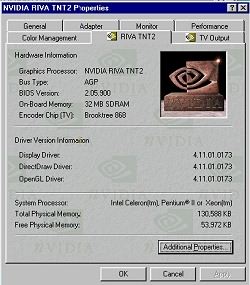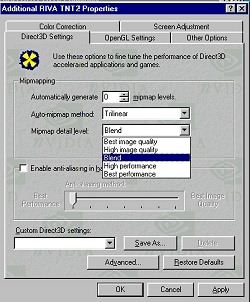| Hot Rod for 2000: Dual Celeron
by Leonard "Viking1" Hjalmarson |
||||
|
Faced with the overwhelming need I pulled my AGP board from its slot and disconnected the power supply and managed to set five jumpers in the required positions. Oddly, the system would not post at 6x75 OR 6x83, but would post happily at 6x100. I thought that the 83MHz bus setting was too high for the IDE subsystem, and indeed the system would boot at 5X83 via soft settings with IDE disconnected. But try as I might, I could not get the system to boot at 6x unless the bus was set at 100MHz. Finally I pulled my IDE drive from the mix and the system posted and booted at 6x75 or 450MHz, but I am still disappointed that these settings are not available in the BIOS. Running a total of 900MHz of processing power (for a cost of about $230 in CPU's) I was in seventh heaven. I expected great things. Then I spoke with Mark Doran, the NT guru. Mark is running Falcon 4 on a dual Xenon system and has discovered that Falcon 4 gets more than a 75% boost in frame rate under the WIN2000 beta! But curiously, it makes no difference whether he pulls one of the processors or not. Apparently the campaign code is not sufficiently optimized for SMP. Sniffle. No matter; the fact that something about the code of WIN2000 enables this large a boost in Falcon 4 is still significant. Even if I can only test at 400MHz I aim to wring the system out. My first tests will be with V3 3000 and my second set of tests with TNT2. TNT2 For a point of reference, I first clocked the system thoroughly on my Diamond Fusion Banshee. This board is probably the fastest Banshee based board out there and compared favorably to Voodoo3 in my testing last month, usually placing within 10% of the framerate of the V3 3000 in Falcon 4.0. The first thing I noticed with the new system was that the load times for Falcon 4 had been cut to less than half. The "Gilman pie" loading screen flashed by like a slide show in the first three frames, only pausing in the last frame. The VikingII's and I are getting along fine! After writing down the fps numbers for various resolutions I replaced the Banshee with TNT2. Nvidia's TNT2 addresses 32 MB of RAM on board and is rated around 350 million pixels per second or ten million triangles per second. An AGP 4x part, it supports textures up to 2056x2056 and will render in a full 32 bits color. |
 Not the case with the demos supplied, however. Image quality and anti-aliasing settings did make a difference in Rage Software's Expendable, an arcade game where you are a genetically engineered soldier. But what about the games that interest you and I? In fact, TNT2 will do anti-aliasing in hardware, but it seems the software must also support this feature. I turned on anti-aliasing for F4, running at 800x600 on a 21 inch monitor, but could see no difference in image or in performance.
 Voodoo 3 Still Reigns Voodoo3 still holds the lead in my testing. I created a TE mission that is somewhat CPU dependent, but not nearly so much as the Falcon 4 campaign. Entry point in the mission is in the air with a single wingman, at exactly the same time and place each entry. I ran the graphics settings and flight options identically for each test mission. Incredibly, the TNT2 was not only slower than the Voodoo3 3000, it was actually slower than my Diamond Fusion Banshee under Direct3d. At 800x600 with the 2d cockpit the Banshee was pushing 28 fps in D3d and the TNT2 was pushing 26 fps. In the no cockpit view at 1024x768 TNT2 fared better, pushing out 34 fps to Banshee's 31 fps. Go to Part VI
|
|||
|
Copyright © 1997 - 2000 COMBATSIM.COM, INC. All Rights Reserved. Last Updated May 6th, 1999 |
||||
